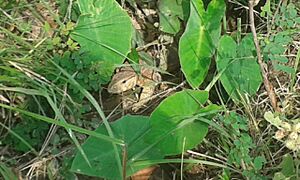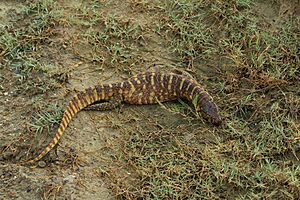Yellow monitor facts for kids
Quick facts for kids Yellow (golden) monitor lizard |
|
|---|---|
 |
|
| Conservation status | |
| Scientific classification | |
| Genus: |
Varanus
|
| Species: |
flavescens
|
The yellow monitor is also known as the golden monitor. It's a type of monitor lizard that lives in South Asia. Its scientific name is 'Varanus flavescens'.
Contents
What Does a Yellow Monitor Look Like?
Yellow monitors are medium-sized lizards. They can grow to be about 45 to 95 centimeters (about 1.5 to 3 feet) long, including their tail. They usually weigh up to 1.45 kilograms (about 3.2 pounds).
They have a short, rounded snout. Their nostrils are small slits, closer to the tip of their nose than to their eyes. Their toes are short. The fourth toe is not longer than their upper leg. Their tail is slightly flat and has a ridge on top.
The scales on their head are small. The scales on their upper body are oval-shaped and have a ridge. The scales on their belly are smooth.
Adult yellow monitors are olive green or yellowish-brown on top. They have dark, irregular patterns that often form wide stripes across their body. They also have a dark stripe near their temples. Their underside is yellowish, with faint brown stripes, especially on their throat. Young yellow monitors are dark brown with yellow spots that form stripes. Their underside is yellow with dark brown stripes.
Where Do Yellow Monitors Live?

Yellow monitors live in the flood plains of big rivers like the Indus, Ganges, and Brahmaputra. You can find them in India, Pakistan, Nepal, and Bangladesh.
They prefer wet areas, like the edges of forests. They also live near human towns and farms. Because their back toes are short, they are not very good at climbing trees.
How Do Yellow Monitors Behave?
Yellow monitors are active during the day. Like other lizards, they control their body temperature by moving between sunny and shady spots. This is called thermoregulation. There was even one report of a yellow monitor lying on warm ash from a fire. It seemed to be warming itself up.
These lizards might even play! One yellow monitor was seen in a wetland. It kept switching between swimming upright and floating still in the water.
Why Are Yellow Monitors in Danger?
The biggest danger to yellow monitors is being killed by people. Many local people do not know much about these lizards. This lack of knowledge leads to most of the killings. Sadly, many are killed for their skin, which is then sold illegally.
Even protected areas are not enough to save them. Most places where yellow monitors live are outside these safe zones. They are often found close to human homes. This makes them more likely to be hunted. In Nepal, their skin has been seen for sale in wildlife markets.
How Are We Protecting Them?
The yellow monitor is a protected animal in most countries where it lives. This includes Nepal, India, Bhutan, and Bangladesh. However, we do not know exactly how many yellow monitors there are. We also do not know if their numbers are going up or down.
Even in their favorite habitats, there are not many yellow monitors. Some studies suggest their numbers are decreasing. But more research is needed to confirm this trend.



